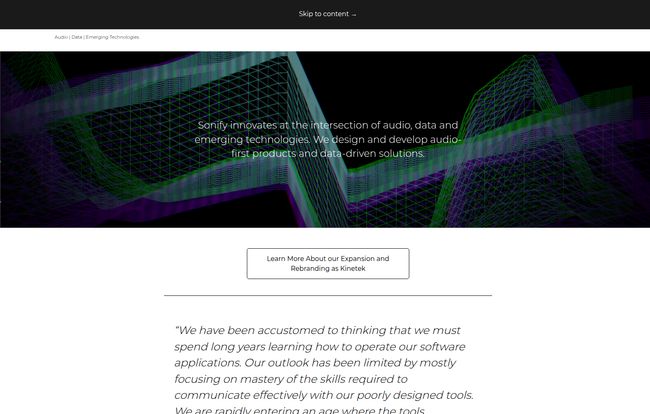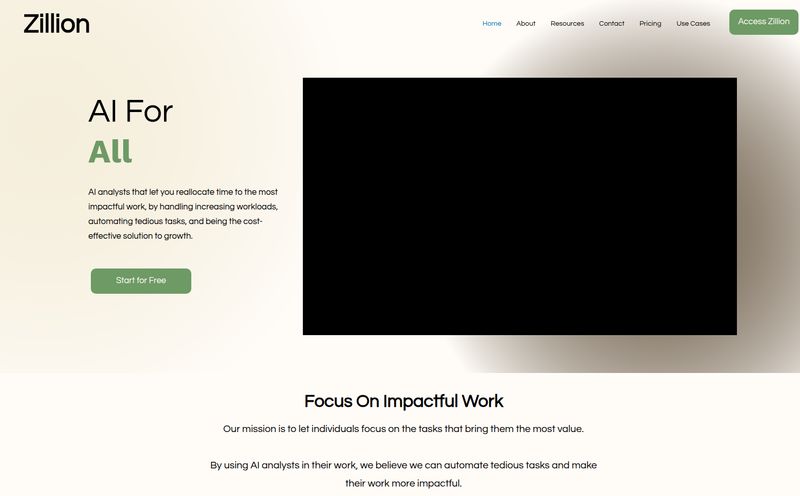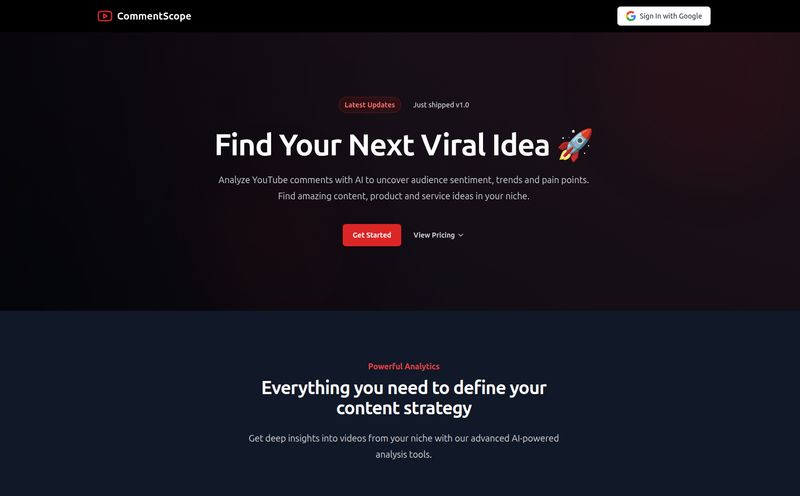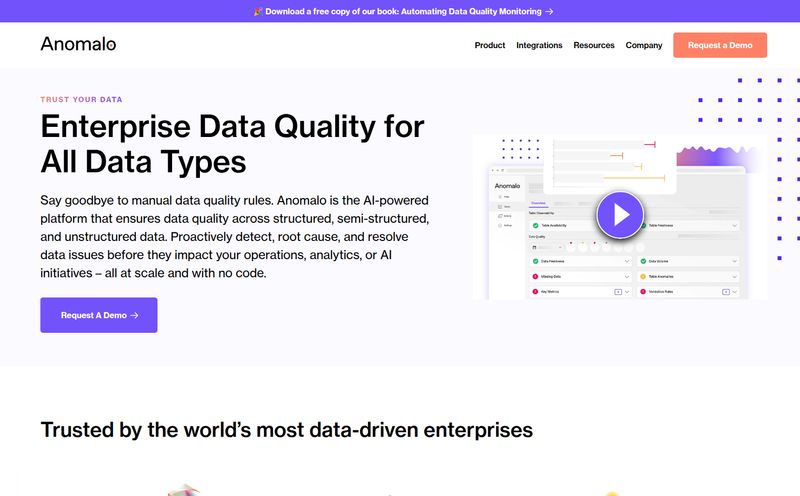If I have to stare at one more Google Analytics dashboard with its endless rows, columns, and squiggly lines that all somehow look both urgent and meaningless at the same time, I might just lose it. We're in the data business, right? We live and breathe this stuff. But for years, our relationship with data has been purely visual.
It’s a staring contest we’re destined to lose. We build bigger monitors, cram in more charts, and color-code everything into oblivion, hoping to somehow see the one insight that matters.
But what if we’ve been missing something? What if we could… listen to our data?
I know, it sounds a bit out there. Like something from a sci-fi movie. But a company called Sonify is making this a reality, and honestly, it’s one of the most exciting things I’ve stumbled upon in a while. They’re not just building tools; they’re proposing a whole new way to interact with information. And it’s about time.
So, What in the World is Data Sonification?
At its core, data sonification is the art and science of turning data into sound. Think of it like this: instead of a line graph showing your website traffic over a month, you hear a melody. The pitch rises during a traffic spike, the tempo quickens during peak hours, and maybe a dissonant chord plays when your bounce rate shoots up. It’s not just random noise; it's information, translated into a different sensory language.
Some people might write this off as a novelty. A party trick for data scientists. But as a quote I saw on Sonify’s site (from a Forbes article) brilliantly points out, we're already listening to our devices more than ever. “Some might be inclined to dismiss sonification as a novelty, but a new generation of screenless devices with conversational interfaces (Alexa, Siri etc.) means we are more routinely listening to devices.”
That one hit me. We ask Siri for the weather, we tell Alexa to play a song. Our world is becoming increasingly audio-first. Why should data be left behind, trapped in the visual realm?
Meet Sonify, The Conductors of the Data Orchestra
This brings me to the team at Sonify. Their mission statement on their homepage says it all: “We have become a society of viewers… we have almost entirely ignored our other senses.” They operate at what they call “the intersection of audio, data, and emerging technologies.”
They’re not just selling a single product. From what I can gather, they are a blend of a design studio, a research lab, and a solutions provider. They’re the experts you call when you want to explore the sonic potential of your information.

Visit Sonify
This Is More Than Just Beeps and Boops
A quick look at their past projects shows this isn't just theory. They've worked with some seriously heavy hitters. We're talking collaborations with Stanford University, NYU, and FNB. They’ve been featured in VentureBeat for their work with AI in sonification. This isn't a garage startup with a wacky idea; it's a team of dedicated experts pushing a legitimate frontier.
They even have an open-source app called TwoTone, which lets anyone experiment with turning data into sound. I love this. It shows they're committed to building a community around the idea, not just hoarding the technology for themselves.
A Genuine Mission for Accessibility
Here’s the part that really got me. One of their highlighted projects is called “Making Data Accessible,” and it focuses on an application for blind and visually impaired individuals. And suddenly, sonification goes from a “cool idea for marketers” to something profoundly important.
Imagine a world where a financial analyst who is blind can hear the stock market's performance, or a scientist with low vision can listen to the patterns in their experimental results. This is a game-changer for inclusivity. It democratizes access to information in a way that staring at charts never could. It stops being a cool alternative and starts becoming a necessary one. For me, this is Sonify's most powerful selling point.
So, How Does This Actually Work? (The Tech Angle)
Sonify focuses on “audio-first product development” and “data-driven solutions.” They aren’t just slapping a sound file onto a spreadsheet. They're designing experiences from the ground up with sound as the primary medium. This involves a deep understanding of psychoacoustics (how humans perceive sound), music theory, and, of course, data science.
By integrating emerging tech like AI, they can create more nuanced and responsive soundscapes. The AI can learn what a “normal” data pattern sounds like for your business, and then create a specific audio alert—a unique sonic signature—for when an anomaly occurs. It's like having a watchdog for your data that barks in different ways for different intruders.
The Elephant in the Room: Specifics and Pricing
Okay, let's address the big question. If you go to Sonify’s website right now looking for a “Buy Now” button and a pricing table, you're going to be disappointed. It's one of the first things I noticed. The site is beautiful, and it's a fantastic showcase of their philosophy and past work, but it’s light on specific product details or costs.
Is this a flaw? Maybe. Or maybe it just tells us about their business model. My gut feeling is that Sonify operates more like a high-end consultancy than a SaaS company. You don't just buy their software off the shelf; you partner with them to create a bespoke audio solution for your specific needs. It’s not about a one-size-fits-all dashboard, but a custom-composed symphony for your data.
I did find a broken link or two while poking around their site, which hey, it happens to the best of us, right? It just adds to the feeling that this is a company of brilliant creators who are more focused on the next big idea than on meticulous web maintenance. And I can respect that.
Why Should an SEO or Marketer Even Care?
So why am I, an SEO guy, so jazzed about this? Because the potential applications are just fascinating.
- Real-time Analytics: Imagine having an ambient soundscape in your office that represents your website's traffic. A calm, steady hum for normal activity, a rising, exciting crescendo when a new campaign goes viral. You could feel a traffic spike before you even see it on a chart.
- A/B Testing: Instead of comparing two conversion rates visually, what if you could listen to them? Maybe a successful test has a harmonious, pleasing sound, while the losing variant sounds slightly off-key. It could make identifying the winner more intuitive.
- Brand Storytelling: This is a big one. Companies spend millions on visual branding. What about audio branding? Not just a jingle, but a dynamic “data-driven” sound logo that changes based on the company's public performance or social media sentiment. That's next-level stuff.
It’s about adding a new dimension to our analytical toolkit. It's about spotting patterns that our tired eyes might miss. It’s about making data less of a chore and more of an experience.
Final Thoughts: A New Way of Knowing
Look, Sonify is not going to replace your spreadsheets tomorrow. But they are asking a question that we should all be paying attention to. In a world saturated with visual noise, they're offering a new channel for insight and understanding. Their focus on accessibility proves this is more than a gimmick; it’s a fundamental shift in how we can and should interact with information.
I’m genuinely excited to see where they go next. They are composing the future of data, one note at a time. And I, for one, am listening closely.
Frequently Asked Questions about Sonify
What exactly is Sonify?
Sonify is an innovation company that specializes in turning data into sound, a process known as data sonification. They operate as a mix of a design studio and consultancy, creating audio-first products and data-driven solutions for various industries.
What is data sonification?
It's the practice of using non-speech audio to convey information. Instead of reading a chart or graph, you would listen to a sound or melody that represents the data's patterns, trends, and outliers.
Who is Sonify for?
Their services seem ideal for large organizations, researchers, and companies looking for innovative ways to understand their data, tell stories with it, or make it more accessible. Given their focus on bespoke solutions, it's likely geared towards clients who need a custom-built approach.
How much does Sonify cost?
There is no public pricing information available on their website. This strongly suggests they work on a project-by-project basis, with costs determined by the scope and complexity of the custom solution required. You'd need to contact them directly for a quote.
Can I try Sonify's technology myself?
Yes, to an extent. Sonify developed an open-source web app called TwoTone, which is designed to help anyone get started with data sonification. It’s a great way to experiment with the core concepts.
Is sonification just a gimmick or the real deal?
While it may seem novel, the applications in accessibility for the visually impaired make it a very real and important technology. Furthermore, with the rise of audio-based devices like smart speakers, interacting with data through sound is becoming an increasingly practical and logical next step.
Reference and Sources
- Sonify Official Website
- Forbes: Sonification: Turning The World Into An Interface
- VentureBeat: How AI is enabling a new paradigm for data sonification
- TwoTone - An App for Data Sonification



